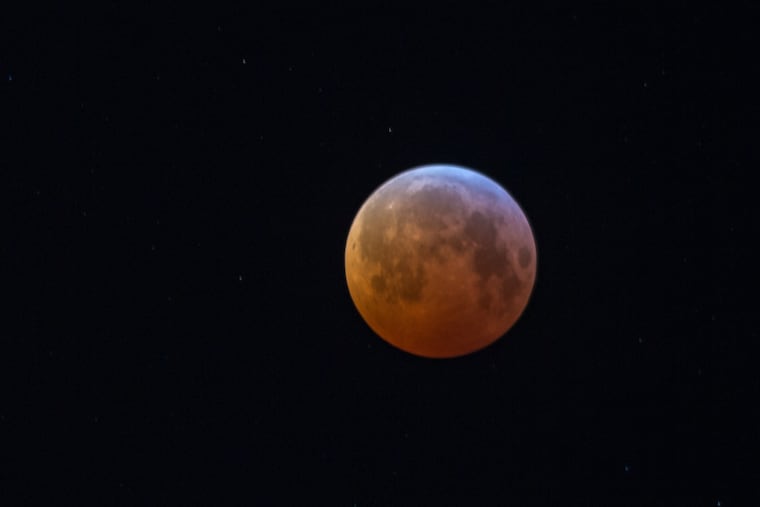‘Blood Moon’ eclipse in the Philly skies will make Election Day history early Tuesday
While the moon is completely in Earth's shadow, it will assume a reddish-copper blush, thus the term 'Blood Moon.'

If you’re up for it, the early-morning skies over much of North America on Tuesday are hosting a spectacular show in which the moon will disappear and then assume a reddish-copper blush during the first total eclipse ever to coincide with a U.S. Election Day.
Fortuitously, the skies will be clear around here, with relatively little water vapor in the air to obstruct the viewing, said Alex Staarmann, a meteorologist at the National Weather Service Office in Mount Holly.
Here’s the rub, however: Save for those with a case of pre-election sleeplessness or early risers: The timing isn’t the best for Philadelphians and other Easterners.
The show starts at 3:02 a.m. EST and “totality,” when the moon will be obscured by Earth’s shadow, won’t begin until 4:09 a.m.
But as opposed to the various election races, this outcome is an absolute certainty.
What’s happening
The sun, Earth, and moon align in such a way that the latter crosses into our planet’s shadow, known as the umbra, and the moon takes on that reddish hue, thus the term “Blood Moon.”
That’s because the only sunlight reaching the lunar surface passes through Earth’s atmosphere, NASA explains, adding, “It’s as if all the world’s sunrises and sunsets are projected onto the moon.”
» READ MORE: Might we be dancing on the moon someday? Space tourism may take off.
This happens periodically, but never before on a U.S. Election Day.
What to expect and when
The moon will enter Earth’s outer shadow, or penumbra, at 3:02 a.m., and as the shadow progresses the moon will be in partial eclipse at 4:09 a.m.
At 5:17 a.m., the moon will be completely overshadowed and will assume a copper color, a great time to admire Mars and Taurus, advises Sky & Telescope.
The moon will be exiting the shadow at 6:42 a.m., which for most East Coast viewers would be around the time of moonset, notes Harry J. Augensen, emeritus professor of physics and astronomy at Widener University. And by then the sun will have risen in Philly and in much of the Eastern Time Zone.
For an eclipse visualization, check out NASA’s Dial-a-Moon.
What’s next
For an encore, the moon, still at near 100% fullness and unobstructed by shadow, will be back on duty Wednesday, rising around sunset time.
» READ MORE: We just changed the clocks, and it looks like we'll keep on changing them
We have entered a peak moon season, with our satellite’s time to shine lengthening as the sun’s time shortens. The trees are shedding leaves, allowing the moonlight to shine through and create those beautifully intricate shadows.
And if you happened to miss this one, the next total lunar eclipse will occur March 14, 2025.